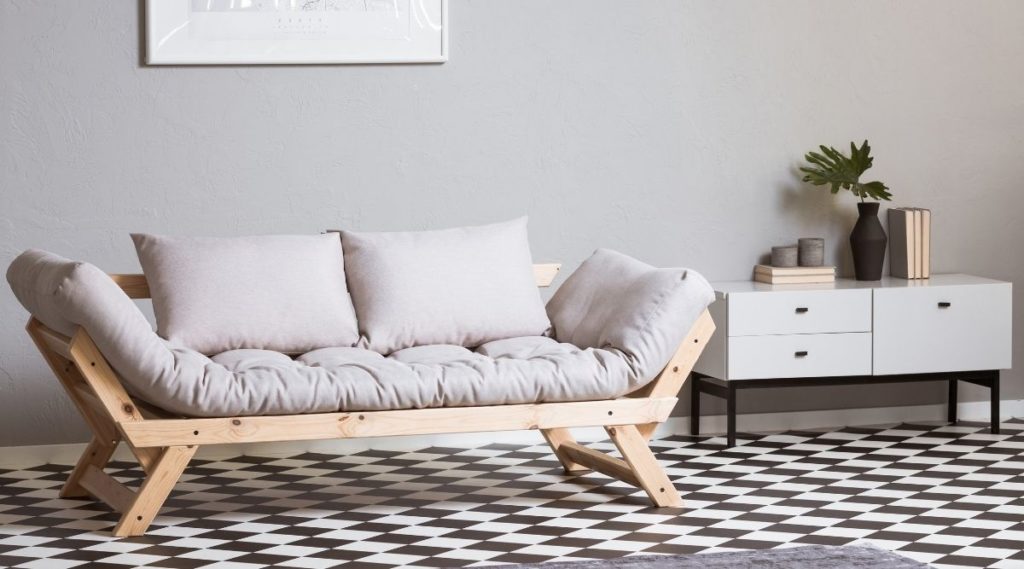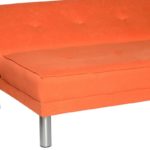
A futon is a type of bedding that originated in Japan.
Designed to be stored away neatly when not in use, futons offer much more space-saving potential than a regular mattress.
So how do futons differ in size, and what are the dimensions of a standard futon?
Futons follow the exact same sizes as normal mattresses, and so adhere to the same standard sizes.
The average futon size is a Full, which is designed for one person. A standard Full-size futon is 54” by 75” (or 4’6”x6’3”). However, you can also get other sizes of the futon, which also adhere to standardized sizes.
The smallest size of the futon is a Twin, which measures 39”x75” (3’3”x6’3”). You can also get a Twin XL, which is 39”x79” (3’3”x6’7) for people who want more head/foot space.
Like mattresses, futons also come in Queen and King sizes. A standard Queen-size futon is 60”x80” (5’x6’8”). A King, meanwhile, measures a whopping 76”x80” (6’4”x6’8”).
Part of a futon’s appeal is how easily you can store them. Futons have the ability to be folded up, letting you keep even the largest futon out of the way when you aren’t using it.
How Much Room Do You Need For A Futon?

Depending on the style and size of the futon you want, the space you need may vary.
Not only will a King-size futon need more space than a Twin futon, but you will also need to account for how you’re using your futon.
If you’re using a futon as a regular (but storable) mattress, you’ll need the same space as you would for a normal mattress. This includes factoring in any frame you would be using.
However, because of a futon’s ability to fold, you may be using it in a different position.
You can arrange your futon into a seat or sofa bed so it has multiple purposes.
Not only will this make your futon a comfortable and space-saving piece of furniture, but you can also pull out and extend your futon to a full-length bed if you want.
Folding a futon into a cushioned chair when you aren’t sleeping on it will help you save on storage space as well as on furniture.
If you’re using a sofa bed or some other frame for your futon, you’ll need to consider this when thinking about space. However, foldable frames will make it much easier to save room in your home, especially if you’re using a futon in place of a sofa when you aren’t sleeping on it.
Because they can be stored easily and aren’t as thick as regular mattresses, futons are great for going under a loft bed.
To safely and comfortably fit a futon beneath a loft bed, you’ll need to have at least 4’ of space between the futon and the bottom of the bed. You should also leave ample space between the loft bed and the ceiling, although using a futon would make this easier to achieve.
What Is The Largest Futon Size?
As mentioned before, the largest standard size of futons is the King size. Like a King-size mattress, these are bigger than any other size of the futon.
However, it’s not exactly clear what this means. There are actually two standard definitions of a King-size mattress, and this applies to futons as well. The two variations of a King-size futon are the California King, and the Eastern King (also referred to as a standard King).
The Eastern King-size mattress has the aforementioned dimensions of 76”x80” (6’4”x6’8”). This style of the futon is best if you want the height of a queen but with more width to spread out in.
The California King, on the other hand, measures in at a whopping 72”x84” (6’x7’). This futon size sacrifices some of its widths to add an extra 4 inches of height.
Because both of these futons have one dimension larger than the other, it isn’t easy to say which variation of the King-size futon is the biggest.
There are also other non-standard sizes, which exceed either of these styles. For instance, the Alaskan-King comes in at a staggering 108”x108”, or 9’x9’. This would easily fit several people with room to spare, and even folded you’ll struggle to find anywhere to store this mammoth futon.
How Deep Is A Futon?

There isn’t a standard depth for a futon, and there are several things that can affect it. Futons can come in a variety of sizes and materials, and these won’t always be the same thickness.
However, futons tend to be thinner than standard mattresses – both to help with their flexibility and storage, but also because futons won’t offer the same support as a mattress will.
While standard mattresses typically range in depth from 8” to 14”, futons have a much lower average. Most futons fall between 3” to 9” thick, depending on their material.
Thicker materials like memory foam, or the inclusion of coils or gel, will bulk out a futon and give it more depth.
You won’t usually have to make any specific adjustments to accommodate a futon over a mattress (in fact, the opposite is true in most cases), but there are some things to consider.
If you’re using a futon in a frame you need to make sure that there aren’t any overhangs. You should also avoid frames with taller lips, as the futon may not be able to reach the top of these.
While this will ensure your futon won’t shift at all, it may be uncomfortable or tricky to get in and out of bed.
Frames will also affect the height of your futon. These vary in height from model to model, but will usually leave your futon higher than a normal sofa, and lower than a bed. While the futon itself will stay in this 3-9 inch range, the total height with frame included could be much more.






